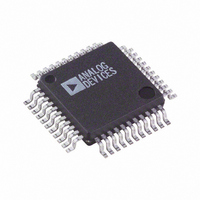AD7865AS-1 Analog Devices Inc, AD7865AS-1 Datasheet - Page 13

AD7865AS-1
Manufacturer Part Number
AD7865AS-1
Description
IC ADC 14BIT DUAL 4CH 44-MQFP
Manufacturer
Analog Devices Inc
Specifications of AD7865AS-1
Rohs Status
RoHS non-compliant
Number Of Bits
14
Sampling Rate (per Second)
350k
Data Interface
Parallel
Number Of Converters
1
Power Dissipation (max)
160mW
Voltage Supply Source
Analog and Digital
Operating Temperature
-40°C ~ 85°C
Mounting Type
Surface Mount
Package / Case
44-MQFP, 44-PQFP
Available stocks
Company
Part Number
Manufacturer
Quantity
Price
Company:
Part Number:
AD7865AS-1
Manufacturer:
ADI
Quantity:
885
Part Number:
AD7865AS-1
Manufacturer:
ADI/亚德诺
Quantity:
20 000
Accessing the Output Data Registers
There are four Output Data Registers, one for each of the four
possible conversion results from a conversion sequence. The
result of the first conversion in a conversion sequence is placed
in Register 1 and the second result is placed in Register 2 and so
on. For example if the conversion sequence V
is selected (see Selecting a Conversion Sequence) the results of
the conversion on V
to 3 respectively. The Output Data register pointer is reset to
point to Register 1 at the end of the first conversion in the
sequence, just prior to EOC going low. At this point the logic
output FRSTDATA will go logic high to indicate that the out-
put data register pointer is addressing Register 1. When CS and
RD are both logic low the contents of the addressed register are
enabled onto the data bus (DB0–DB13).
When reading the output data registers after a conversion
sequence, i.e., when BUSY goes low, the register pointer is
incremented on the rising edge of the RD signal as shown in
Figure 8. However, when reading the conversion results between
conversions in a conversion sequence the pointer will not be
incremented until a valid conversion result is in the register to
be addressed. In this case the pointer is incremented when the
conversion has ended and the result has been transferred to the
output data register. This happens when EOC goes low, there-
fore EOC may be used to enable the register contents onto the
CS
RD
THE POINTER WILL NOT BE INCREMENTED BY A RISING EDGE ON RD UNTIL
THE CONVERSION RESULT IS IN THE OUTPUT DATA REGISTER. THE POINTER
IS RESET WHEN THE LAST CONVERSION RESULT IS READ
POINTER
COUNTER
RESET
2-BIT
FRSTDATA
CONVST
DECODE
DATA
IN1
BUSY
EOC
RD
CS
, V
IN3
t
2
t
and V
AD7865
DATA REGISTERS
OE #1
OE #2
OE #3
OE #4
1
OUTPUT
NOT VALID
IN4
t
are placed in Registers 1
BUSY
(V
(V
(V
IN1
IN3
IN4
)
)
)
IN1
, V
DRIVERS
V
DRIVE
IN3
O/P
OE
FRSTDATA
and V
V
DB0 TO
DB13
IN1
t
6
IN4
t
10
V
IN2
data bus as described in Reading Between Conversions in the
Conversion Sequence. The pointer is reset to point to Register 1
on the rising edge of the RD signal when the last conversion
result in the sequence is being read. In the example shown in
Figure 8, this means that the pointer is set to Register 1 when
the contents of Register 3 are read.
Reading after the Conversion Sequence
Figure 9 shows the same conversion sequence as Figure 7. In
this case, however, the results of the four conversions (on V
to V
BUSY goes logic low. The FRSTDATA signal goes logic high
at the end of the first conversion just prior to EOC going logic
low. As mentioned previously FRSTDATA has an indetermi-
nate state after initial power up, therefore FRSTDATA may
already be logic high. Unlike the case when reading during a
conversion the output data register pointer is incremented on
the rising edge of RD because the next conversion result is avail-
able in this case. This means FRSTDATA will go logic low after
the first rising edge on RD.
Successive read operations will access the remaining conversion
results in ascending channel order. Each read operation incre-
ments the output data register pointer. The read operation that
accesses the last conversion result causes the output data regis-
ter pointer to be reset so that the next read operation will access
the first conversion result again. This is shown in Figure 8 with
the fifth read after BUSY goes low accessing the result of the
conversion on V
circular buffer in which the conversion results may be continu-
ally accessed. The FRSTDATA signal will go high when the
first conversion result is available.
Data is enabled onto the data bus DB0 to DB13 using CS and
RD. Both CS and RD have the same functionality as described
in the previous section. There are no restrictions or performance
implications associated with the position of the read operations
after BUSY goes low, however there is a minimum time between
read operations that must be adhered to. Notice also that a “Quiet
Time” is needed before the start of the next conversion sequence.
t
3
t
8
t
7
IN4
) are read after all conversions have finished, i.e., when
V
IN3
t
4
IN1
V
IN4
. Thus the output data registers acts as a
t
10
QUIET
TIME
V
IN1
AD7865
IN1













